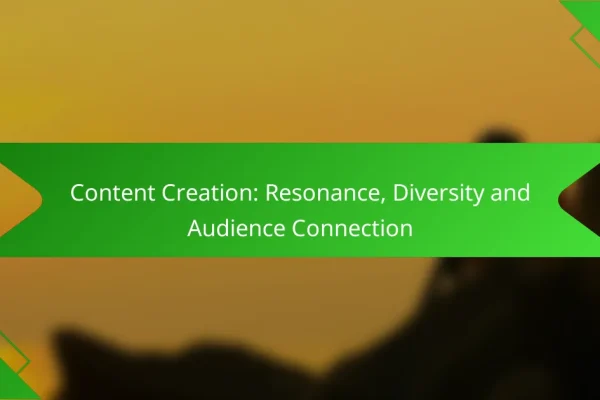How can you identify your audience’s needs?
Identifying your audience’s needs involves gathering information about their preferences, challenges, and interests. This understanding helps tailor your content effectively to engage and resonate with them.
Conduct surveys and interviews
Surveys and interviews are direct methods to gather insights from your audience. You can use online tools to create surveys that ask specific questions about their preferences and needs. Aim for a sample size that reflects your target audience to ensure reliable data.
Interviews provide deeper insights, allowing for open-ended questions that can reveal motivations and pain points. Consider scheduling interviews with a diverse group to capture a range of perspectives.
Analyze audience demographics
Understanding audience demographics is crucial for tailoring your content. Analyze factors such as age, gender, location, and income level to create a profile of your typical audience member. This information helps you adjust your messaging and tone to better suit their characteristics.
Utilize tools like Google Analytics or social media insights to gather demographic data. Look for trends that can inform your content strategy, such as the most engaged age group or geographic location.
Utilize social media insights
Social media platforms offer valuable insights into audience behavior and preferences. Use analytics tools provided by platforms like Facebook, Instagram, or Twitter to track engagement metrics, such as likes, shares, and comments. These metrics can indicate what content resonates most with your audience.
Monitor conversations and comments to understand audience sentiment and interests. Engaging with your audience through polls or questions can also provide real-time feedback on their needs.
Review competitor analysis
Competitor analysis helps you understand how similar audiences engage with other brands. Identify your main competitors and analyze their content strategies, audience engagement, and messaging. Look for gaps in their approach that you can capitalize on.
Tools like SEMrush or Ahrefs can provide insights into competitors’ traffic sources and popular content. This information can guide your strategy to better meet your audience’s needs by offering unique value that competitors may overlook.
What writing techniques engage your audience?
Engaging your audience requires using techniques that resonate with their interests and experiences. Effective writing methods include storytelling, relatable examples, and clear language, all of which help maintain reader attention and enhance understanding.
Use storytelling methods
Storytelling captivates readers by creating emotional connections. By weaving narratives into your writing, you can illustrate complex ideas through relatable scenarios, making your content more memorable.
Consider using a structure that includes a beginning, middle, and end. This approach helps guide the reader through your message while keeping them invested in the outcome. For example, share a personal anecdote that aligns with your topic to draw in your audience.
Incorporate relatable examples
Relatable examples help bridge the gap between your content and your audience’s experiences. When readers can see themselves in your examples, they are more likely to engage with your message.
Use everyday situations or common challenges that your audience faces. For instance, if writing for a business audience, reference scenarios like team collaboration or project management. This makes your content applicable and practical.
Apply clear and concise language
Clear and concise language is essential for effective communication. Avoid jargon and overly complex sentences that may confuse your audience, opting instead for straightforward vocabulary and structure.
Aim for brevity without sacrificing meaning. Use short sentences and active voice to convey your points clearly. A good rule of thumb is to keep paragraphs to 2-4 sentences, ensuring that each one delivers a single idea effectively.
How does audience segmentation improve writing?
Audience segmentation enhances writing by allowing authors to tailor their content to specific groups, ensuring that messages resonate more effectively. By understanding the distinct characteristics and preferences of different segments, writers can create more engaging and relevant material.
Tailors content to specific groups
Segmenting your audience enables you to customize your writing style, tone, and content to match the preferences of each group. For instance, a tech company might write differently for industry professionals compared to casual consumers, using jargon for the former and simpler language for the latter.
Consider creating personas for each segment, detailing their demographics, interests, and pain points. This approach helps in crafting messages that directly address the needs and expectations of each audience, leading to better engagement.
Enhances relevance and connection
When writing is tailored to specific audience segments, it becomes more relevant, fostering a stronger connection with readers. By addressing their unique challenges and aspirations, you can create a sense of understanding and trust.
Utilize feedback and analytics to refine your content continually. For example, if a particular segment responds positively to case studies, incorporate more of those into your writing for that group. This iterative process ensures that your content remains aligned with audience interests, enhancing overall effectiveness.
What tools can help understand your audience?
Several tools can provide valuable insights into your audience’s preferences and behaviors. Utilizing these tools can help tailor your content to better meet the needs and interests of your target demographic.
Google Analytics for behavior tracking
Google Analytics is a powerful tool for tracking user behavior on your website. It provides data on visitor demographics, session duration, bounce rates, and page views, allowing you to understand how users interact with your content.
To make the most of Google Analytics, focus on key metrics such as user acquisition channels and the most visited pages. This information can guide your content strategy and help you identify areas for improvement.
BuzzSumo for content performance
BuzzSumo allows you to analyze the performance of your content across various platforms. By entering a topic or domain, you can see which pieces of content have generated the most engagement, shares, and backlinks.
Use BuzzSumo to identify trending topics and successful formats in your niche. This can inform your content creation process, ensuring that you produce material that resonates with your audience.
SEMrush for keyword insights
SEMrush is an essential tool for gaining keyword insights and understanding what your audience is searching for online. It provides data on keyword volume, competition, and related keywords, helping you optimize your content for search engines.
When using SEMrush, focus on long-tail keywords that have lower competition but high relevance to your audience. This strategy can improve your visibility and attract more targeted traffic to your website.
What are the key attributes of effective writing?
Effective writing is characterized by clarity, engagement, and emotional resonance. These attributes ensure that the message is not only understood but also resonates with the audience, making the writing impactful.
Clarity and coherence
Clarity in writing means presenting ideas in a straightforward manner, allowing readers to grasp the message without confusion. Coherence ensures that all parts of the text connect logically, guiding the reader through the argument or narrative seamlessly.
To achieve clarity, use simple language and avoid jargon unless necessary. Break complex ideas into smaller, digestible parts and use headings or bullet points to organize information. Aim for a reading level appropriate for your audience, which can vary from basic to advanced depending on the context.
Engagement and emotional appeal
Engagement refers to the ability of writing to capture and maintain the reader’s interest. Emotional appeal connects with the audience on a personal level, making the content more relatable and memorable.
To enhance engagement, incorporate storytelling techniques, such as anecdotes or vivid descriptions. Use questions to provoke thought and encourage readers to reflect on their own experiences. Emotional appeal can be strengthened by addressing the audience’s values, fears, or aspirations, making the writing resonate more deeply.










